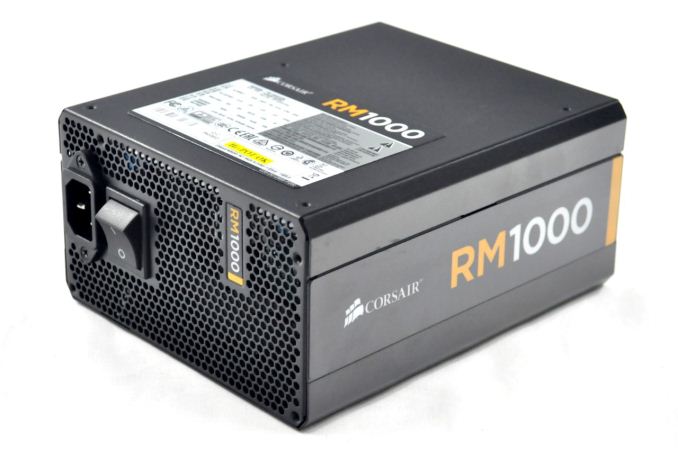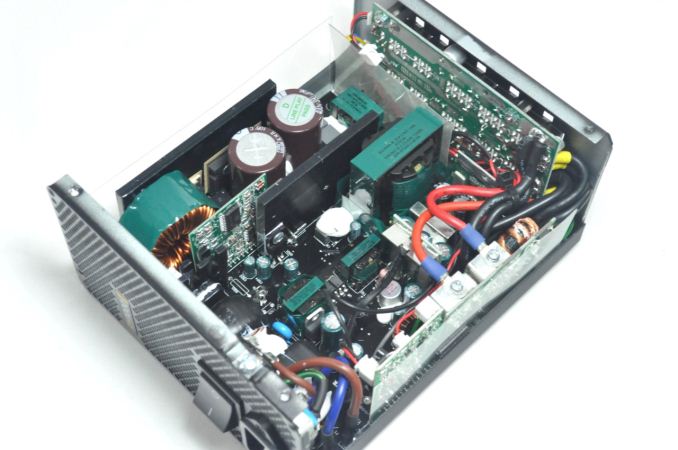Corsair RM1000 Power Supply Review
by E. Fylladitakis on April 24, 2014 6:00 AM EST- Posted in
- Cases/Cooling/PSUs
- Corsair
- PSUs
- RM Series
External Appearance
Corsair painted the chassis of the RM1000 a matte black color, as the company usually does with their PSUs. Aesthetic improvements include chamfered edges and decorative stickers on the sides of the power supply, as well as parallel, embossed ridges aligned with the fan's finger guard design. Note that the chassis of the Corsair RM1000 is 180mm long, which is significantly longer than typical ATX PSUs. This could be a problem if the PSU is to be installed inside a small or low-cost case, but that seems unlikely considering the class and power output of the unit. Regardless, you'll want to make sure your case is able to accommodate such a large PSU.
Corsair placed the sticker with the specifications of the PSU on the top of the chassis as the front of the chassis is littered with the connectors for the modular cables and the sides of the Corsair and RM1000 logos. The CPU and PCI-E cables share the same style connectors, the split 10-14 pin connector is for the ATX cable and the smaller connectors are for SATA/Molex cables. There is also a small connector for the Corsair Link interface. We should note that the RM1000 sports the "Basic" Corsair Link interface, which allows you to monitor some basic figures (e.g. fan speed and the 12V line amperage), but it is far less interesting than the complete monitoring capabilities of their top-tier digital models.
Internal Design
The 135mm fan responsible for the cooling of the RM1000 is a Corsair NR135L fan. As even the UL certification number points back to Corsair, this technically is Corsair's own unique product and not a re-branded fan, though some Chinese factory still makes it for them. It has a rifle bearing and a maximum speed of about 1600 RPM. At this point we should note that the RM1000 features a "zero-RPM fan mode", meaning that the fan will not start until the load reaches a significant load (about 40%).
As we noted in the introduction, the OEM behind the RM1000 is Channel Well Technologies (CWT). The first thing that you'll notice about the design is not some special feature or fancy component but the heatsinks, which are preposterously small for a 1000W unit that is designed for low-noise operation and features a fanless mode. In fact, the heatsinks not only are small but also are nothing more than simple quadrangular metallic slabs, with minimal heat dissipation surface. Apparently, Corsair has placed a lot of faith on CWT's design and efficiency, especially considering the five year warranty they provide.
The 400V / 390 μF APFC capacitors are high quality parts supplied by Nippon Chemi-Con. The rest of the electrolytic capacitors are supplied by TAICON and CapXon, Taiwanese companies, with the exception of a stray small Nippon Chemi-Con on the connector's PCB. Although TAICON is not very well known, it is an old company and the quality of their products is considered to be on par with their (similarly priced) Japanese counterparts. CapXon is a very well known company and makes above-average quality products, but they've also had a couple of failed series in the past that rightfully reduced the reputation of the company amongst enthusiasts.
The build quality of the RM1000 is excellent overall. The soldering job is very good, with zero bad joints or burnings, only a few spots where the assembler was too generous with the solder. For mechanical cohesion, the manufacturer used a lot of glue to secure most components. An extra application of lacquer and glue can be seen on the inductors, most likely to minimize the chance of vibration-generated noise (also known as "coil whine").
























55 Comments
View All Comments
piroroadkill - Thursday, April 24, 2014 - link
Solid enough, but personally I have no love for Channel Well Technology.Streetwind - Friday, April 25, 2014 - link
Bit of a shortsighted notion... CWT is an OEM, they manufacture in exactly those quality levels that their customers request. If a customer asks for a cheap piece of crap, the OEM will produce them a cheap piece of crap. But if Corsair says that they need a high quality product, CWT builds them a high quality product. PSU production is not rocket science; it's all about how many corners you're willing to cut to drive the price down.dirtyferret - Thursday, April 24, 2014 - link
I've owned two CWT PSU and 5-6 seasonic OEM units. Maybe I was lucky but I never had any issue with the CWT units I have owned with both working well for 5+ years. I did get an antec (seasonic oem) with a bad coil, my other seasonic PSU never had an issue.tech6 - Thursday, April 24, 2014 - link
With CPUs and GPUs becoming more efficient there really is a very small market for 1kW PSUs. Even with dedicated mid-range gaming graphics cards, a lot of new PC never exceed 350W. I wish PSU makers would put as much effort into efficient and quiet low wattage products as they do with overkill products like these.2late2die - Thursday, April 24, 2014 - link
Well to be fair the entire RM line is geared towards quiet and efficient operation, so if you want that with low wattage just get the 450W unit. Of course 1kW units are geared towards the smaller enthusiast market, always have been and probably will always be. With that being said, if you want to build a powerful system (not necessarily cutting edge, but above mid-range) and keep quiet, then you want the 850W or 1kW unit because of the whole "no fan below 40%" thing. Like you said, many systems, even at load might not reach 40%, which just means that your 1kW unit will always work completely silently, so that's one less fan for you to worry about.Daniel Egger - Thursday, April 24, 2014 - link
That doesn't make sense. A high output unit will almost always have a higher loss and thus emit more heat. In other words: it's actually easier to produce a fanless 400W unit than to produce a 1000W unit that runs with a fan at 0 RPM below 400W.PEJUman - Thursday, April 24, 2014 - link
^^not exactly, you're correct for PSUs from 10 years ago, however the 80 certification requirements forces the modern PSU design to be efficient at all loads:the 80 gold requirements: min efficiency @ 20% load = 0.87, 50% load at = 0.9, 100% load = 0.87
Therefore a 450W 80 Gold will only be 3% (6 Watts) more efficient than a 1000W 80 gold at 200W load.
Daniel Egger - Friday, April 25, 2014 - link
My point is this: If you want to build a system designed for 400W max output it does *not* make sense to use a 1000W just because it happens to run at 0RPM below 40% utilisation.BTW: Not sure your what you meant by "you're correct for PSUs from 10 years ago" because your own calculation proves that I'm still correct for current PSUs. 6W are nothing to sneeze especially considering that no decent system has an idle load of 200W, not even an unlocked haswell setup with crossfire r9 295x2 cf. http://www.anandtech.com/show/7930/the-amd-radeon-... (which this PSU couldn't drive anyway) and those figures are going to be much worse for sane setups.
owan - Friday, June 27, 2014 - link
He didn't say at Idle, he said 200W load. Considering that PSU's are most efficient at 50% load, it actually makes some sense to size your PSU to keep the max load closer to 50% than 100%, particularly if you run your system at high loads for a high percentage of its uptime (i.e. long rendering times, long gaming sessions with minimal other usage) With a high end system drawing well over 500W from the wall, a 1000W PSU is a perfectly sane choiceUnknownZA - Thursday, August 20, 2015 - link
The problem is that new GPU's like Maxw ell do draw more power. A normal 980 GTX Ti apparently only draws 250W which is excellent. However, most if not all of the overclocked 980 GTX Ti's that are on the market draw much more power.I have a GALAX 980 GTX Ti HOF and under full load it draws close to 480W.
I currently have a Corsair TX 750W which I thought was more than enough power for my system, currently Z68 with 2600K, but bought a 4790K and Z97 too. However I have had quite a few crashes while playing games and I have come to the conclusion that the PSU is not suppling enough power. So I am looking at this 1000W Corsair RM. I could go with the 850 but the price difference is negligible.